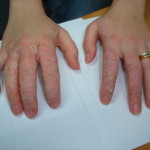Allergic contact dermatitis
Allergic contact dermatitis is a delayed type of allergy that causes a rash to develop. Allergy is very individual (i.e. one person may be allergic to something that another person can use with no problems). It can occur at any time, even if you have been using the same product for many years or just a few weeks. With this form of dermatitis, the rash appears 8 to 24 hours after contact and lasts for several days, and sometimes more.
If the skin is already damaged, such as being dry and cracked, the risk of becoming allergic to something is much higher. Once an allergy to something has developed, it is lifelong and even the smallest amount of contact with that particular chemical will cause the rash to appear again.
Only certain chemicals have the potential to cause allergic reactions. It is said that there are approximately 100,000 chemicals, but only about 4,000 have been reported to cause allergic contact dermatitis. Some very strong substances, such as kerosene, do not cause allergy, but are extremely irritating to the skin.
Whether people develop an allergic reaction depends on:
- The type of chemical
- Concentration of the chemical on the skin
- Duration of skin contact
- Individual tendency to develop allergy

Common causes of allergic contact dermatitis are
- Hair dye
- Nickel, found in silver jewellery and belt buckles
- Chromate which is found in cement and used in tanned leather
- Rubber chemicals, also called accelerators, which can be found in gloves
- Glues and coatings such as epoxy resins
- Preservatives in skin care products
- Fragrances
Patch testing is the diagnostic test used to see if a person is allergic to substances. See the section on patch testing for more information.
